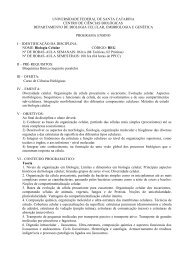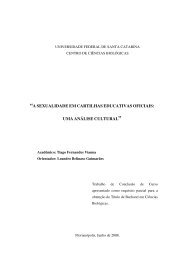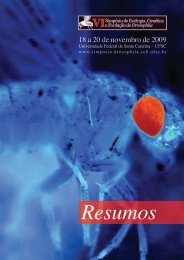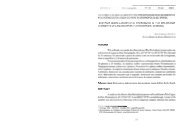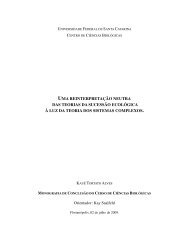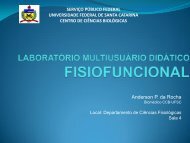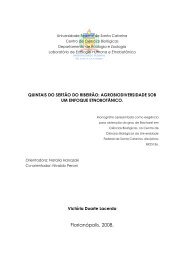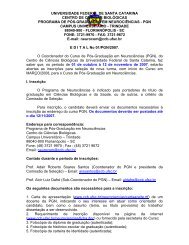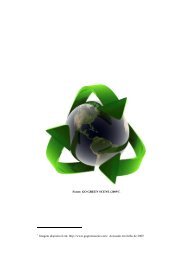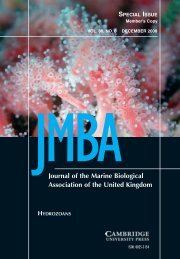Phylogenetics of Trachylina (Cnidaria: Hydrozoa) with new insights ...
Phylogenetics of Trachylina (Cnidaria: Hydrozoa) with new insights ...
Phylogenetics of Trachylina (Cnidaria: Hydrozoa) with new insights ...
- No tags were found...
You also want an ePaper? Increase the reach of your titles
YUMPU automatically turns print PDFs into web optimized ePapers that Google loves.
1684 allen g. collins et al.Bouillon J. and Deroux G. (1967) Remarques sur des Cnidaires du typede Microhydrula pontica Valkanov 1965, trouvés a Rosc<strong>of</strong>f. Cahiers deBiologie Marine 8, 253–272.Brooks W.K. (1886) Life history <strong>of</strong> the Hydromedusae. A discussion <strong>of</strong>the medusae and <strong>of</strong> the significance <strong>of</strong> metagenesis. Memoirs <strong>of</strong> theBoston Society <strong>of</strong> Natural History 3, 359–430.Browne E.T. and Kramp P.L. (1939) Hydromedusae from the FalklandIslands. Discovery Reports XVIII, 265–322.Castresana J. (2000) Selection <strong>of</strong> conserved blocks from multiple alignmentsfor their use in phylogenetic analysis. Molecular Biology andEvolution 17, 540–552.Clausen C. (1971) Interstitial <strong>Cnidaria</strong>: present status <strong>of</strong> their systematicsand ecology. Smithsonian Contributions to Zoology 76, 1–8.Collins A.G. (2002) Phylogeny <strong>of</strong> Medusozoa and the evolution <strong>of</strong> cnidarianlife cycles. Journal <strong>of</strong> Evolutionary Biology 15, 418–432.Collins A.G., Schuchert P., Marques A.C., Jankowski T., Medina M.and Schierwater B. (2006a) Medusozoan phylogeny and characterevolution clarified by <strong>new</strong> large and small subunit rDNA data andan assessment <strong>of</strong> the utility <strong>of</strong> phylogenetic mixture models.Systematic Biology 55, 97–115.Collins A.G., Bentlage B., Matsumoto G.I., Haddock S.H.D., Osborn K.and Schierwater B. (2006b) Solution to the phylogenetic enigma <strong>of</strong>Tetraplatia, a worm-shaped cnidarian. Biology Letters 2, 120–124.Cunningham C.W. and Buss L.W. (1993) Molecular evidence for multipleepisodes <strong>of</strong> pedomorphosis in the family Hydractiniidae.Biochemical Systematics and Ecology 21, 57–69.Daly M., Brugler M.R., Cartwright P., Collins A.G., Dawson M.N.,Fautin D.G., France S.C., McFadden C.S., Opresko D.M.,Rodrigues E., Romano S.L. and Stake J.L. (2007) The phylum<strong>Cnidaria</strong>: a review <strong>of</strong> phylogenetic patterns and diversity 300 yearsafter Linnaeus. Zootaxa 1668, 127–182.Edgar R.C. (2004) MUSCLE: multiple sequence alignment <strong>with</strong> highaccuracy and high throughput. Nucleic Acids Research 32, 1792–1797.Edwards C. (1973) Contributory thoughts on form, function, habitat andclassification <strong>of</strong> hydroids and hydromedusae. Publications <strong>of</strong> the SetoMarine Biological Laboratory 20, 11–22.Gould S.J. (1977) Ontogeny and phylogeny. Cambridge, MA: BelknapPress.Govindarajan A.F., Halanych K.M. and Cunningham C.W. (2005)Mitochondrial evolution and phylogeography in the hydrozoanObelia geniculata (<strong>Cnidaria</strong>). Marine Biology 146, 213–222.Hand C. (1955) A study <strong>of</strong> the structure, affinities, and distribution <strong>of</strong>Tetraplatia volitans Busch (Coelenterata: <strong>Hydrozoa</strong>: Pteromedusae).Pacific Science 9, 332–348.Hashimoto H. (1981) The fresh water hydroid Astrohydra japonica <strong>new</strong>genus <strong>new</strong> species. Annotationes Zoologicae Japoneses 54, 207–212.Hashimoto H. (1985) Medusa <strong>of</strong> fresh-water hydroid Astrohydra japonica.Annotationes Zoologicae Japoneses 2, 761–766.Hyman L.H. (1940) The invertebrates, vol. 1. Protozoa through Ctenophora.New York: McGraw-Hill.Jankowski T. (2001) The freshwater jellyfish <strong>of</strong> the world—a taxonomicand systematic literature study. Hydrobiologia 462, 91–113.Jankowski T., Collins A.G. and Campbell R. (2008) Global diversity <strong>of</strong>inland water cnidarians. Hydrobiologia 595, 35–40.Jarms G. and Tiemann H. (1996) On a hydropolyp <strong>with</strong>out tentaclesMicrohydrula limopsicola n. sp., epibiontic on bivalve shells from theAntarctic. Scientia Marina 60, 109–115.Kikinger R. and Salvini-Plawen L.V. (1995) Development from polyp tostauromedusa in Stylocoronella (<strong>Cnidaria</strong>: Scyphozoa). Journal <strong>of</strong> theMarine Biological Association <strong>of</strong> the United Kingdom 75, 899–912.Kramp P.L. (1938) Die meduse von Ostroumovia inkermanica(Pal.-Ostr.) und die systematische stellung der olindiiden.Zoologischer Anzeiger 122, 103–108.Marques A.C. and Collins A.G. (2004) Cladistic analysis <strong>of</strong> Medusozoaand cnidarian evolution. Invertebrate Biology 123, 23–42.Medina M., Collins A.G., Silberman J.D. and Sogin M.L. (2001)Evaluating hypotheses <strong>of</strong> basal animal phylogeny using completesequences <strong>of</strong> large and small subunit rRNA. Proceedings <strong>of</strong> theNational Academy <strong>of</strong> Sciences <strong>of</strong> the United States <strong>of</strong> America 98,9707–9712.Medlin L., Elwood H.J., Stickel S. and Sogin M.L. (1988) The characterization<strong>of</strong> enzymatically amplified eukaryotic 16S-like rRNA-codingregions. Gene 71, 491–499.Metschnik<strong>of</strong>f E. (1886) Embryologische Studien an Medusen. Ein BeitragZur Genealogie der Primitiv-Organe. Wien: Alfred Hölder.Miglietta M.P., Piraino S., Kubato S. and Schuchert P. (2007) Species inthe genus Turritopsis (<strong>Cnidaria</strong>, <strong>Hydrozoa</strong>): a molecularevaluation. Journal <strong>of</strong> Zoological Systematics and EvolutionaryResearch 45, 11–19.Mühlhardt C. (2003) Molekularbiologie—genomics. Heidelberg: SpektrumAkademischer Verlag.Naumov D.V. (1960) Hydroids and hydromedusae <strong>of</strong> the USSR. Jerusalem:Israel Programme for Scientific Translations. [Translated fromRussian (1969).]Norenburg J.L. and Morse M.P. (1983) Euphysa ruthae(Athecata, Corymorphidae) sp. n., a psammophilic solitary hydroid<strong>with</strong> statocysts and reversed polarity buds, <strong>with</strong> a discussion <strong>of</strong> euphysinecharacters. Transactions <strong>of</strong> the American Microscopical Society102, 1–17.Petersen K.W. (1990) Evolution and taxonomy in capitate hydroids andmedusae (<strong>Cnidaria</strong>: <strong>Hydrozoa</strong>). Zoological Journal <strong>of</strong> the LinnaeanSociety 100, 101–231.Posada D. and Crandall K.A. (1998) MODELTEST: testing the model <strong>of</strong>DNA substitution. Bioinformatics 14, 817–818.Raikova E.V. (1994) Life cycle, cytology, and morphology <strong>of</strong> Polypodiumhydriforme, a coelenterate parasite <strong>of</strong> the eggs <strong>of</strong> acipenseriform fishes.Journal <strong>of</strong> Parasitology 80, 1–22.Rees W.J. (1958) The relationships <strong>of</strong> Moerisia lyonsi Boulenger and thefamily Moerisiidae, <strong>with</strong> capitate hydroids. Proceedings <strong>of</strong> theZoological Society <strong>of</strong> London 130, 537–545.Remane A. (1927) Halammohydra, ein eigenartiges Hydrozoon der NordundOstsee. Zeitschrift für Morphologie und Ökologie der Tiere 7,643–677.Salvini-Plawen L.V. (1987) Mesopsammic <strong>Cnidaria</strong> from Plymouth (<strong>with</strong>systematic notes). Journal <strong>of</strong> the Marine Biological Association <strong>of</strong> theUnited Kingdom 67, 623–637.Schuchert P. (1996) The marine fauna <strong>of</strong> New Zealand: athecate hydroidsand their Medusae (<strong>Cnidaria</strong>: <strong>Hydrozoa</strong>). Wellington: New ZealandOceanographic Institute.Schuchert P. (1998) How many hydrozoan species are there? ZoologischeVerhandelingen 323, 209–219.Schuchert P. (2005) Species boundaries in the hydrozoan genus Coryne.Molecular <strong>Phylogenetics</strong> and Evolution 36, 194–199.Schuchert P. (2007) The <strong>Hydrozoa</strong> Directory, Version 15, September 2007.(http://www.ville-ge.ch/musinfo/mhng/hydrozoa/hydrozoa-directory.htm).




